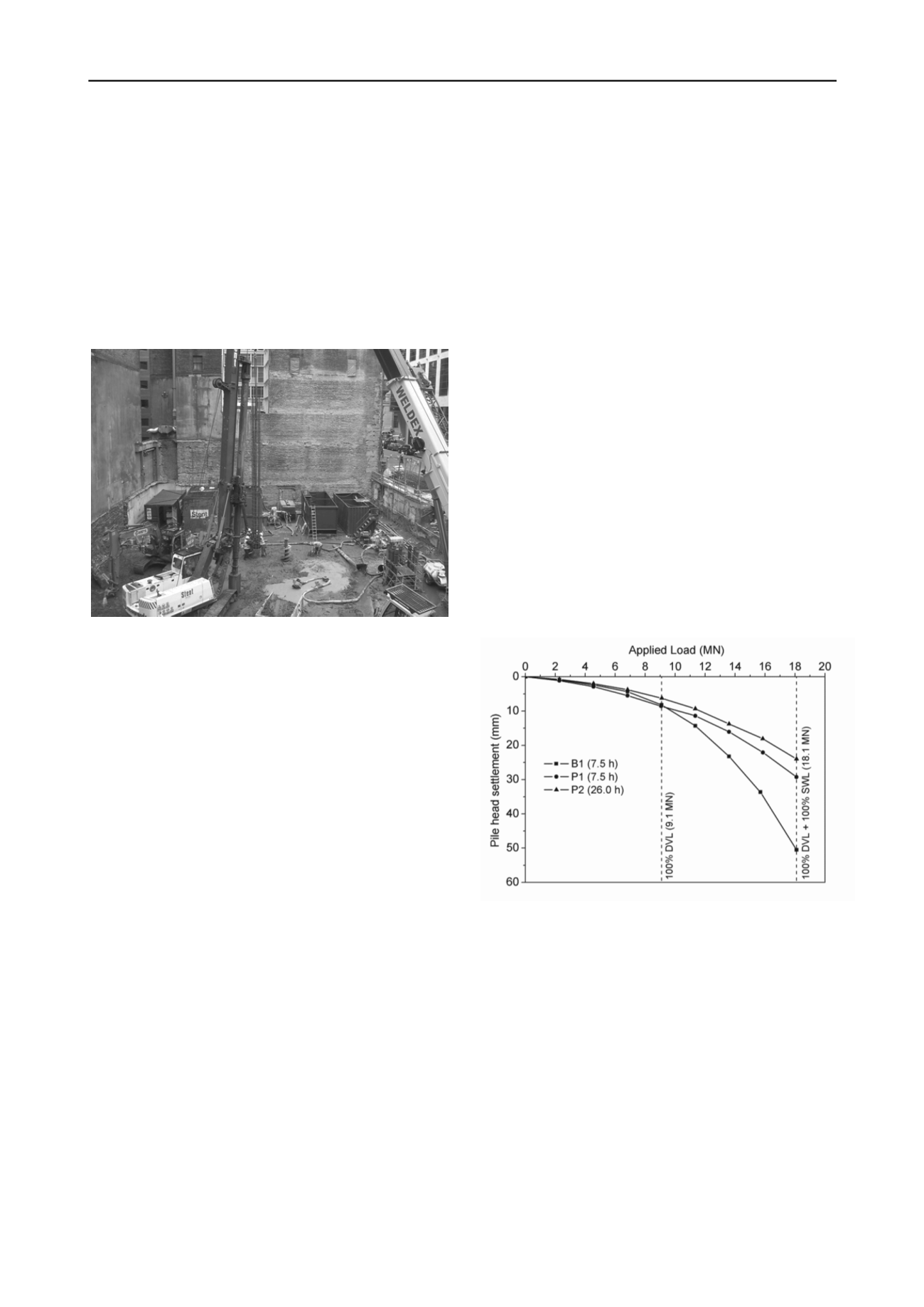
3220
Proceedings of the 18
th
International Conference on Soil Mechanics and Geotechnical Engineering, Paris 2013
centres. Figure 1 shows such a site in central Glasgow, UK
which although measuring just 24 m by 40 m required sixty-two
750 mm diameter bored piles, i.e., approximately one pile every
4 m. The size of the site and the scope of the work meant that
polymer fluids were the only feasible option because they do
not require multiple holding tanks for slurry hydration nor do
they require separation plant to recover the used slurry. Unlike
bentonite slurries, polymer fluids require only a short swelling
and hydration time prior to use and indeed emulsion polymers
develop their properties almost instantaneously after mixing.
Powered polymers, after wetting out, for example, with a
Venturi eductor can be hydrated in an open-top tank gently
agitated with a compressed air lance.
igure 1. The small site in Glasgow where a polymer fluid was used.
nonymous (2001) note that during the construction of the
Cha
nificant environmental benefits
to landfill is banned in many
co
F
A
nnel Tunnel Rail Link (CTRL) East Kent-Ashford to
Cheriton section, polymers were chosen because setting up a
bentonite plant on some of the sites would have been almost
impossible due to space restrictions. The saving of time for site
set-up is an associated advantage. Compact polymer plant can
be moved from site to site relatively quickly whereas mobilising
a bentonite set-up can absorb much valuable programme time.
2.2
Environmental benefits
Polymer fluids can offer sig
when compared to their clay-based counterparts. For example,
although used bentonite may be classified as a non-hazardous
waste, it can be highly polluting if released into the aquatic
environment. For projects near watercourses, polymer fluids are
preferred over bentonite as they need not pose a danger to fish
and in particular they do not build up on fish gills causing them
to suffocate (Schünmann 2004).
As the disposal of liquid waste
untries, the final disposal of used bentonite slurries can be
more costly than the purchase of the original bentonite powder.
Polymers are used at perhaps one-fiftieth to one-twentieth of
bentonite concentrations and the products can be broken down
with readily available oxidising agents such as hypochlorite
(bleach) so that after simple settlement the supernatant water
can be disposed to sewer (with the undertaker’s consent) and the
settled fines added to the excavation spoil – ideally for re-use.
Thasnanipan et al. (2003) report that in Bangkok the primary
reason for switching to polymers was, in most cases, to
minimise the environmental issues associated with bentonite
fluids. Caputo (2009) also expressed concerns regarding the
potential environmental impacts associated with the use of
bentonite for the bored piles for a bridge across the Tagus River
in Portugal.
2.3
Improved foundation performance
As outlined above, operational and environmental benefits are
often cited as the main reasons for using polymers rather than
bentonite. However, over the last two decades many field
studies have been carried out to investigate the effects of
polymer fluids and it is now appreciated that they can bring
significantly improved load performance for piles, etc. The
results of a recent UK case history are summarised below.
To assess the effects of different support fluids and of
varying pile bore open times, Lam et al. (2010a) analysed the
results from a full-scale field trial in East London, where the
ground profile was a layer of made ground underlain by the
Lambeth Group and then Thanet Sand. The trial involved the
load testing of three instrumented piles, two of which were
constructed under a polymer fluid and one under bentonite. The
difference between the two polymer piles was the pile bore open
time; one was concreted within 7.5 h of the completion of
excavation (Pile P1) whilst the other was concreted at 26 h (Pile
P2). The bentonite pile (Pile B1) was concreted at 7.5 h.
Figure 2 shows the load-settlement curves of the three piles;
both polymer piles behaved similarly and significantly
outperformed their bentonite counterpart at the maximum test
load of 18 MN – and indeed the pile open for 26 h showed
slightly better behaviour than that open to 7.5 h. Analysis of the
data from the instrumentation on the piles and supporting
laboratory tests demonstrated that the improvement in the load-
settlement characteristics of the polymer piles was due to the
higher shaft resistance and also the clean pile bases (Lam 2011).
The effect of the polymer solution on concrete also was
investigated. This showed that the polymer fluid had a similar
effect on the strength and stiffness of hardened concrete as
bentonite slurry – water from the fluids mixing with the surface
concrete being the issue.
Figure 2. Load-settlement curves of bored piles at the East London test
site. DVL: design verification load; SWL: specified working load.
Whilst the above results clearly demonstrate the potential
benefits of polymer fluids, these will be realised only if suitable
excavation tools are used and there is rigorous base cleaning
prior to concreting. Figure 3 shows the auger used for the trial.
This had twin flights which prevent suction developing in the
fluid column as the auger is withdrawn. Spoil loads onto one
flight and the other remains open allowing free fluid flow.
3 FAILURES THROUGH ABUSE OF POLYMERS
The literature reports many case histories of the successful use
of polymer fluids. However, failures can still occur and polymer
fluids can be used less than optimally as a result of lack of
experience and/or understanding of the properties of the chosen
polymer. In the following sections, a few examples of common
polymer misuses are described.


